
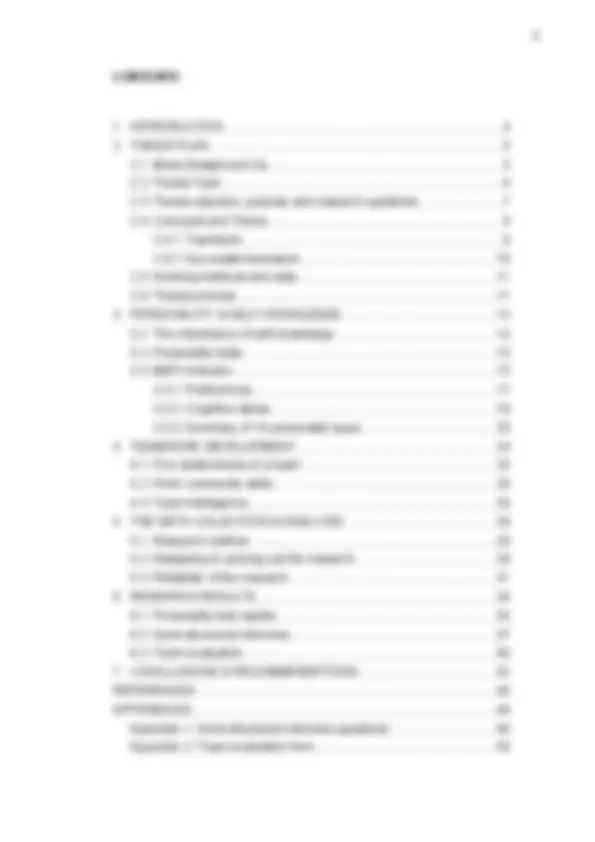
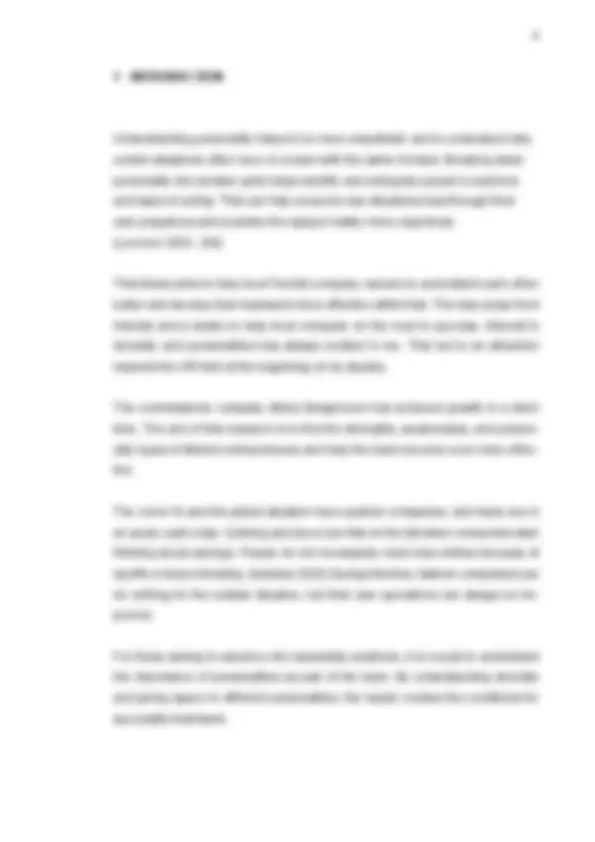
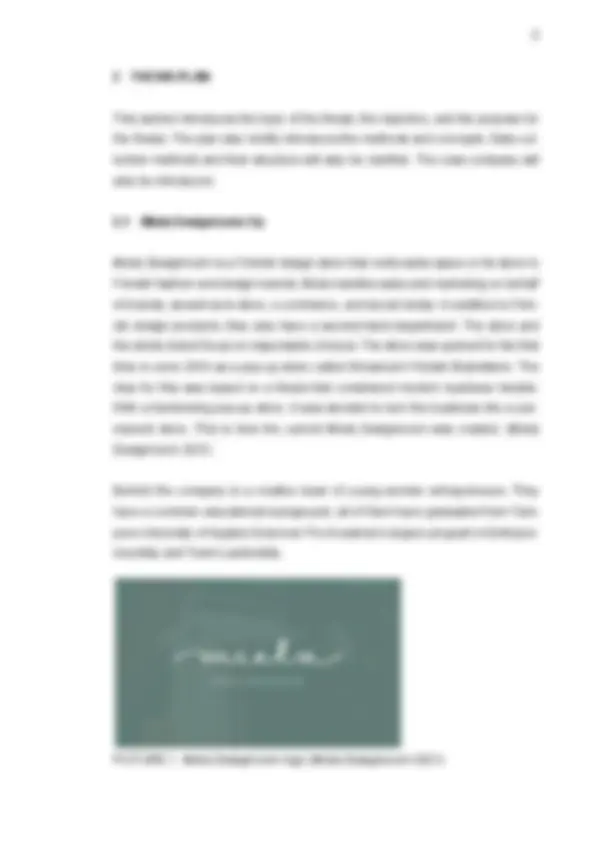
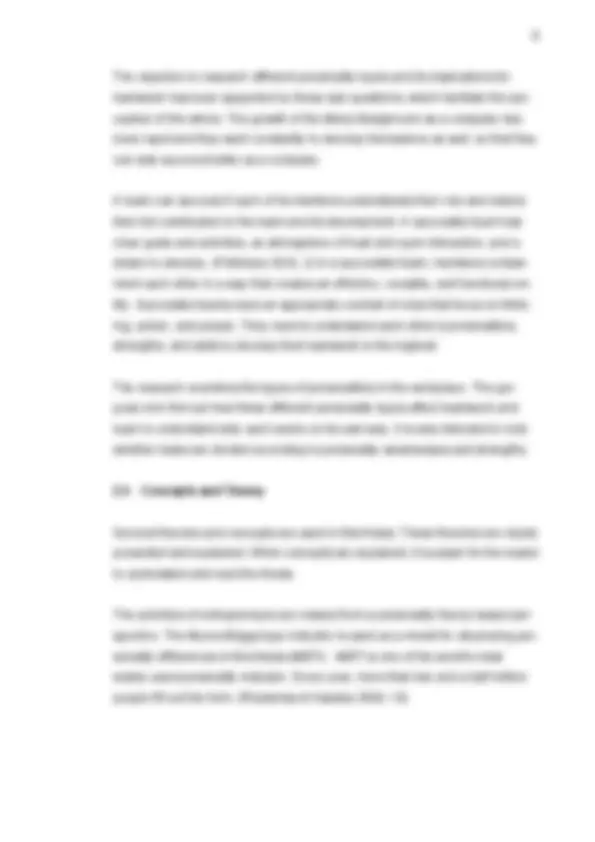
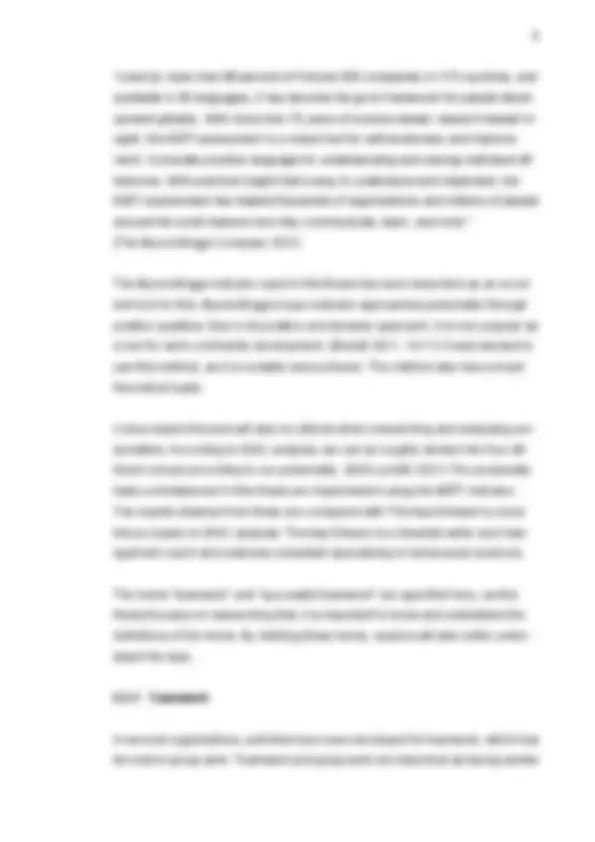
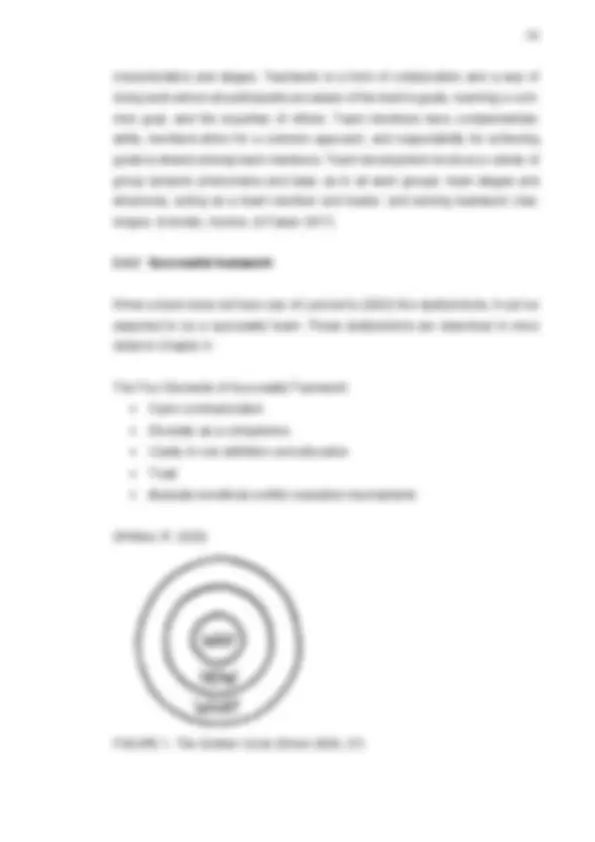
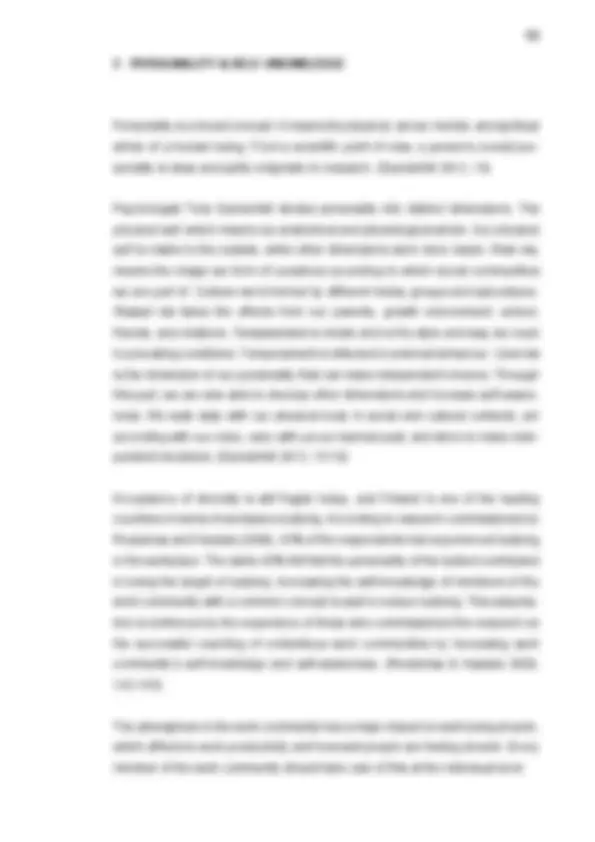
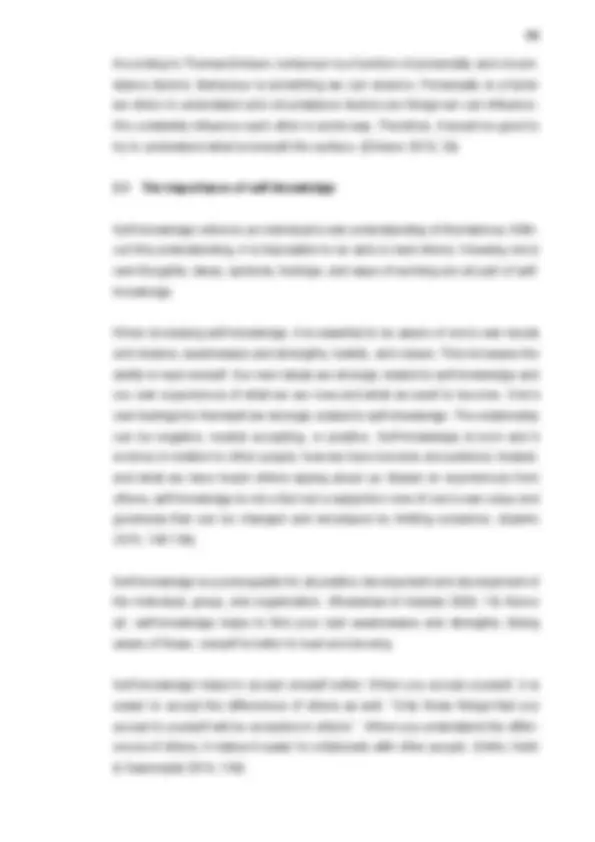
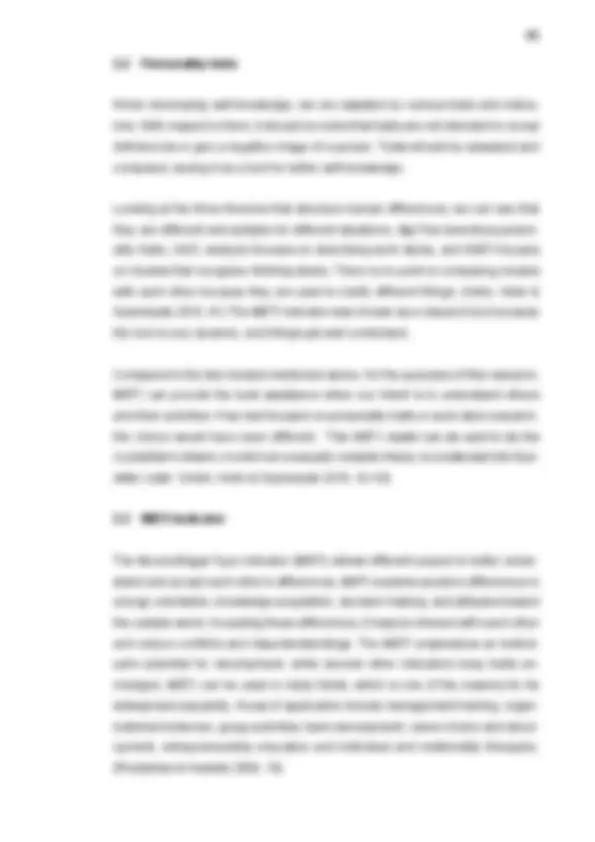
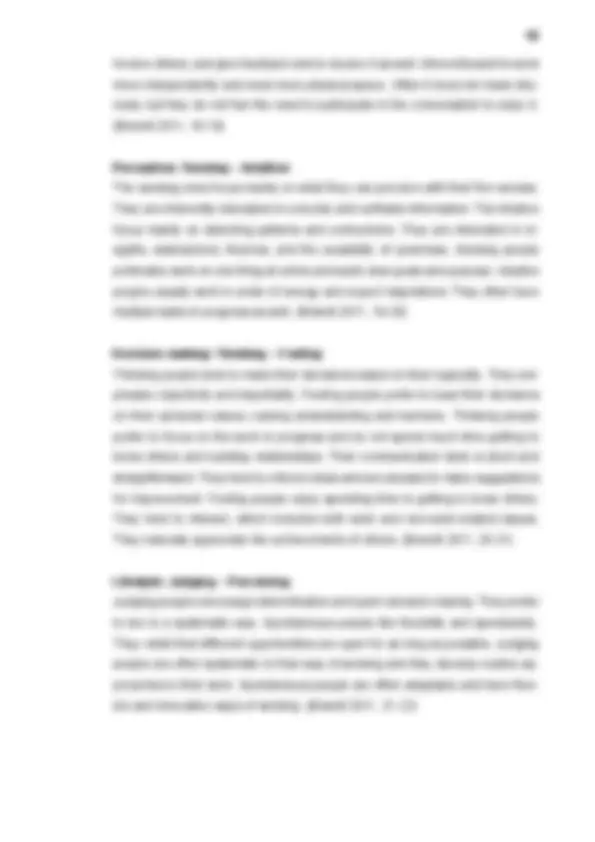
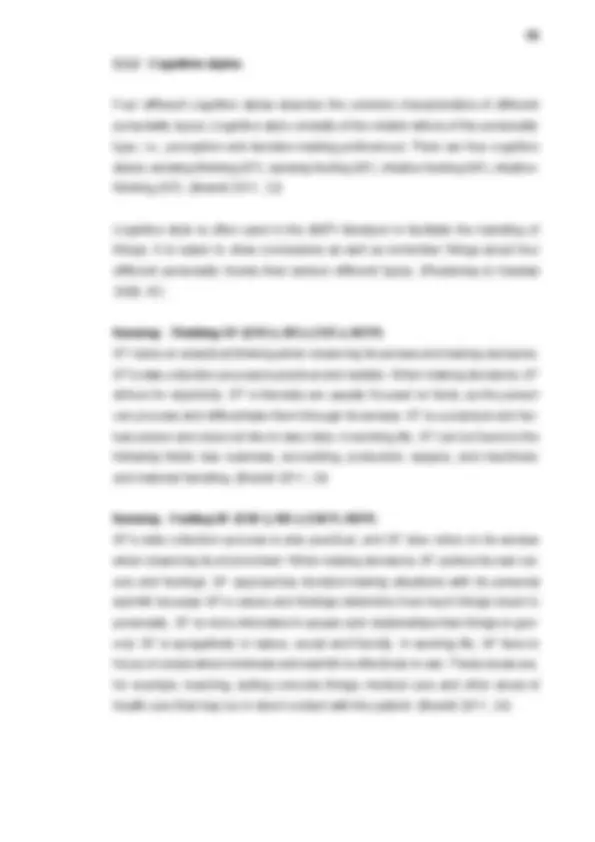
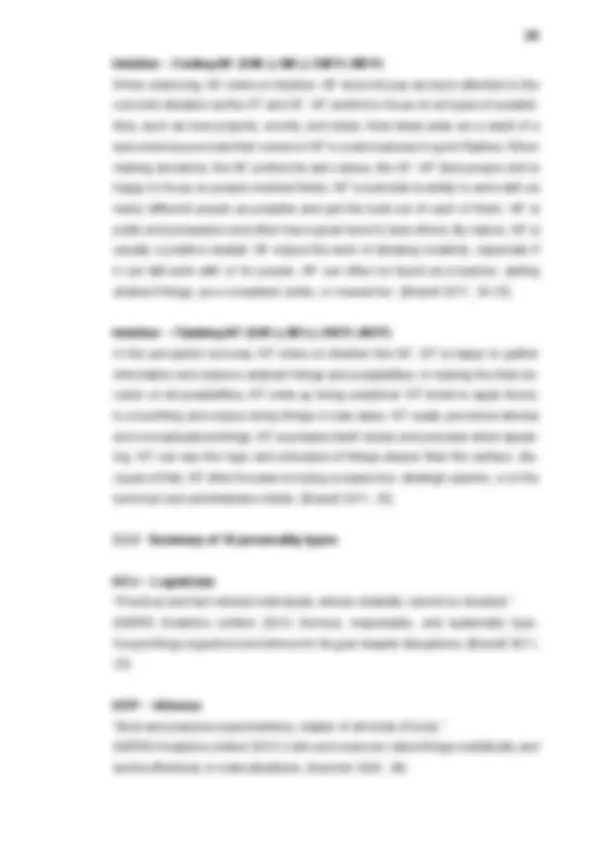
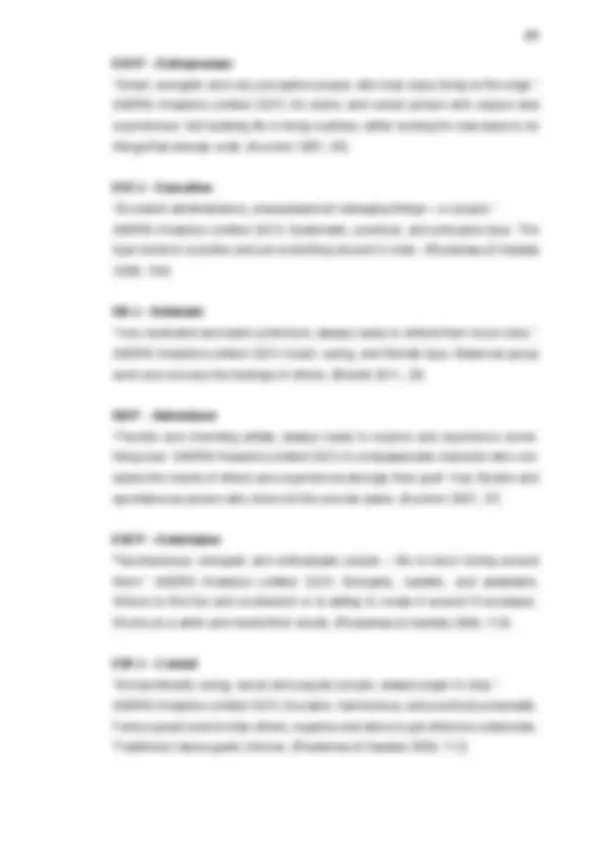
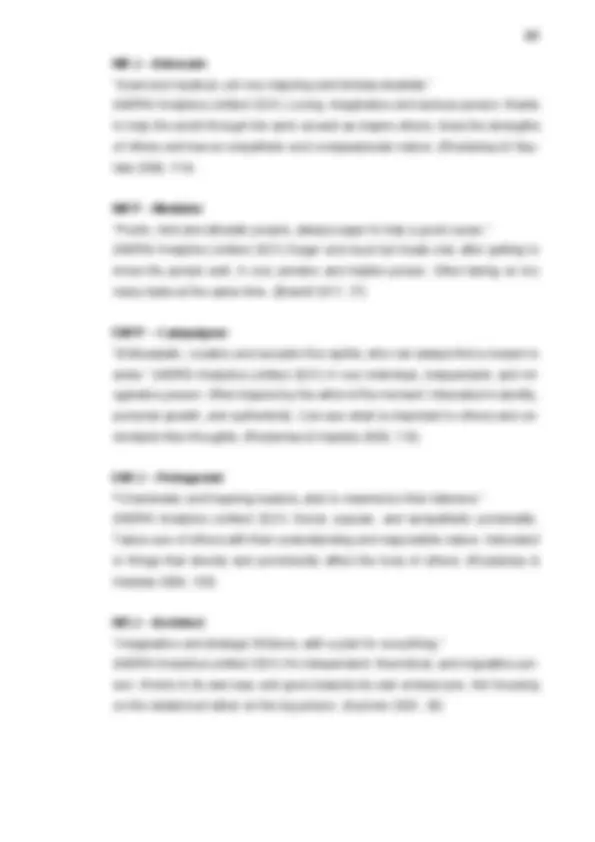
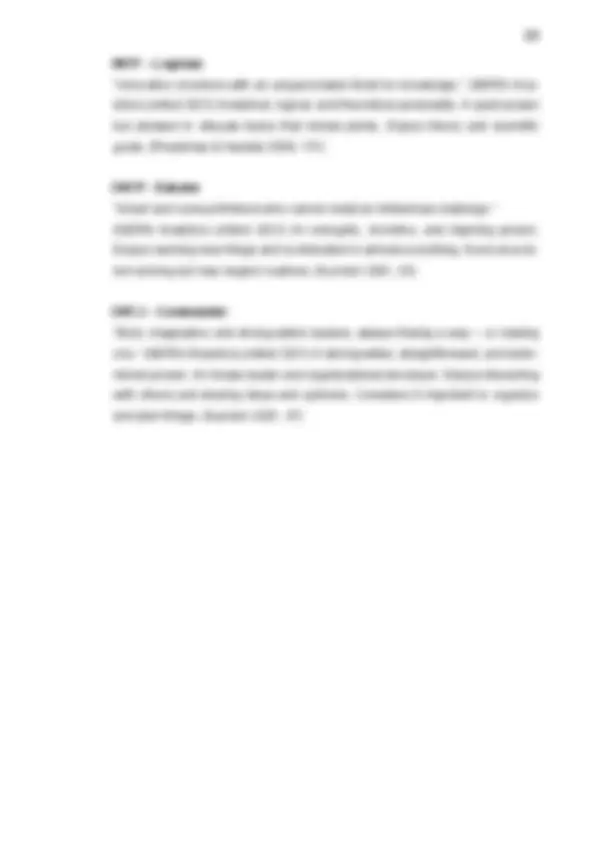
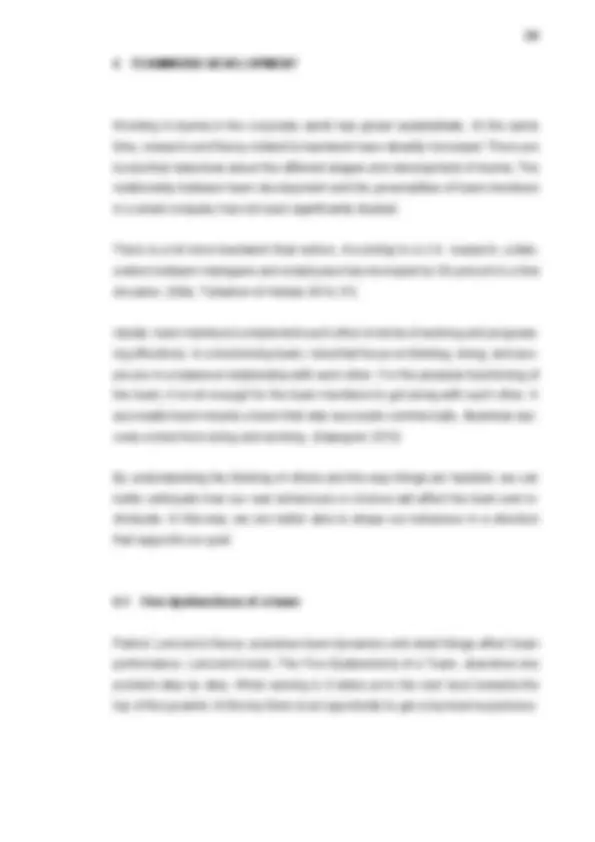
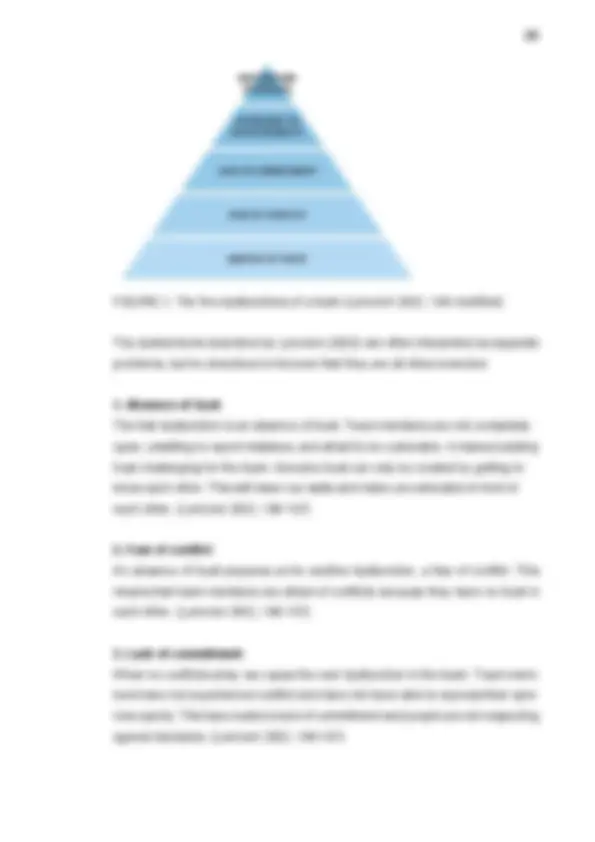
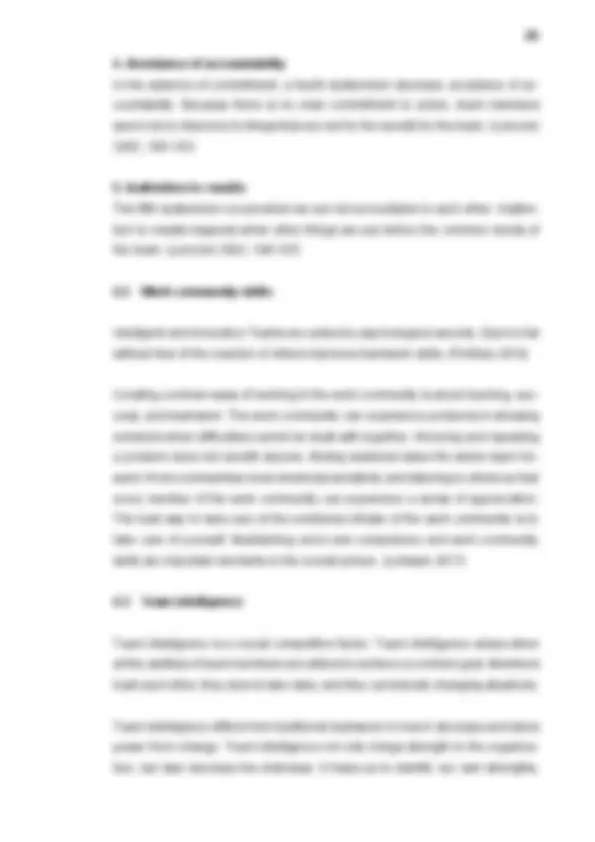
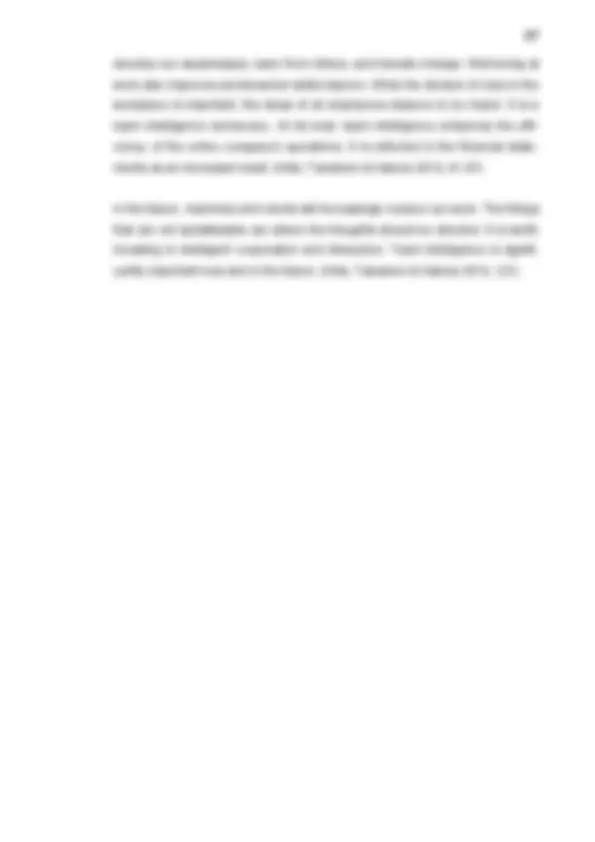
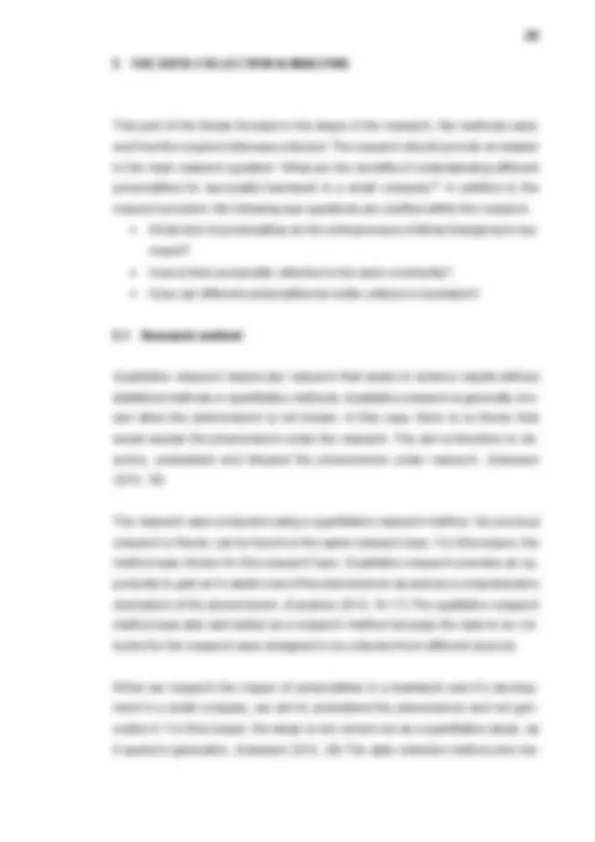
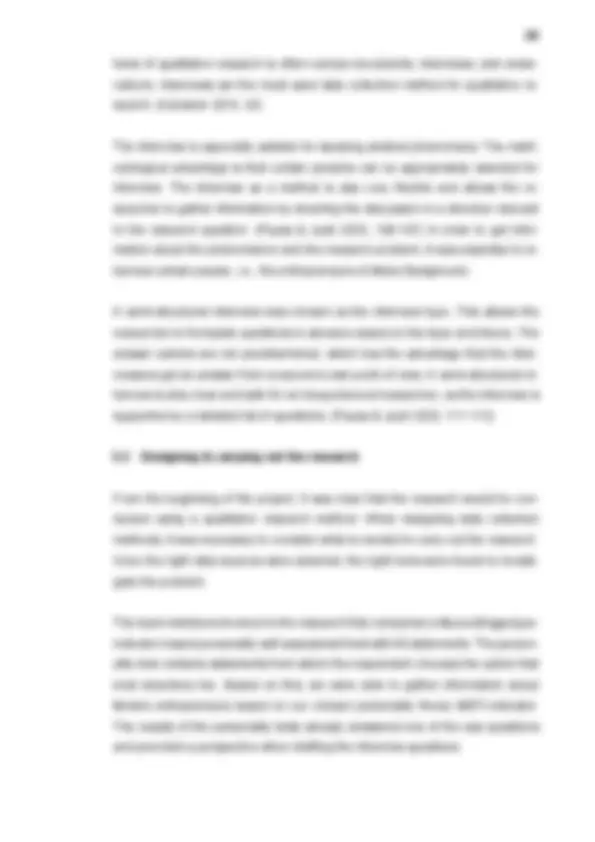
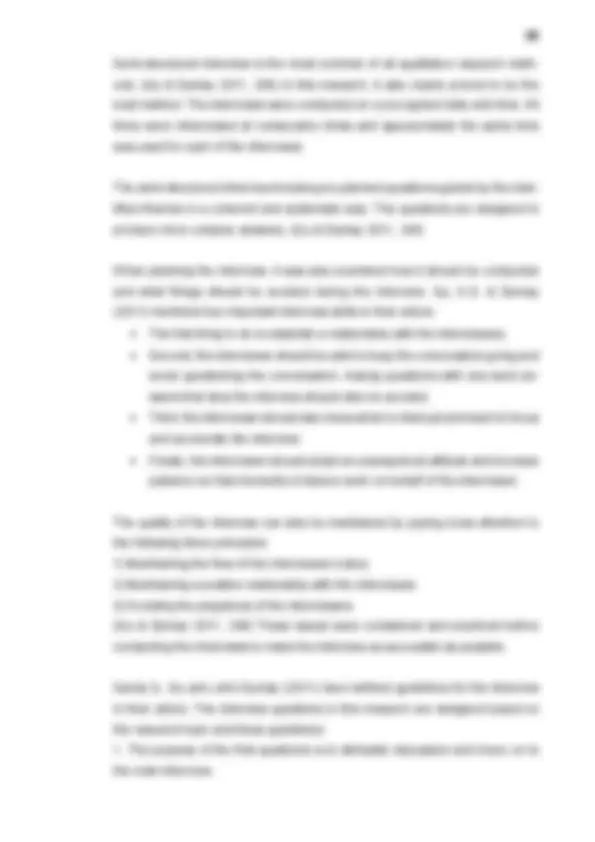

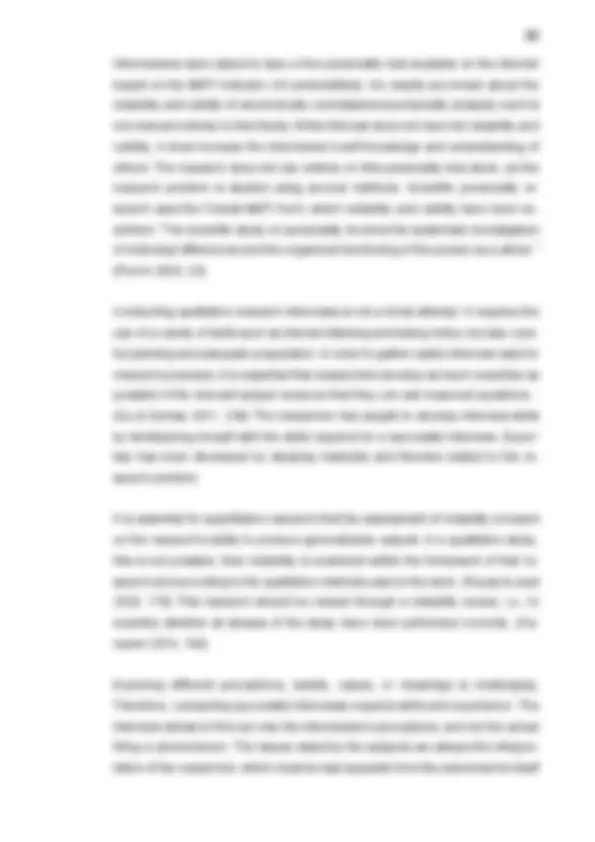
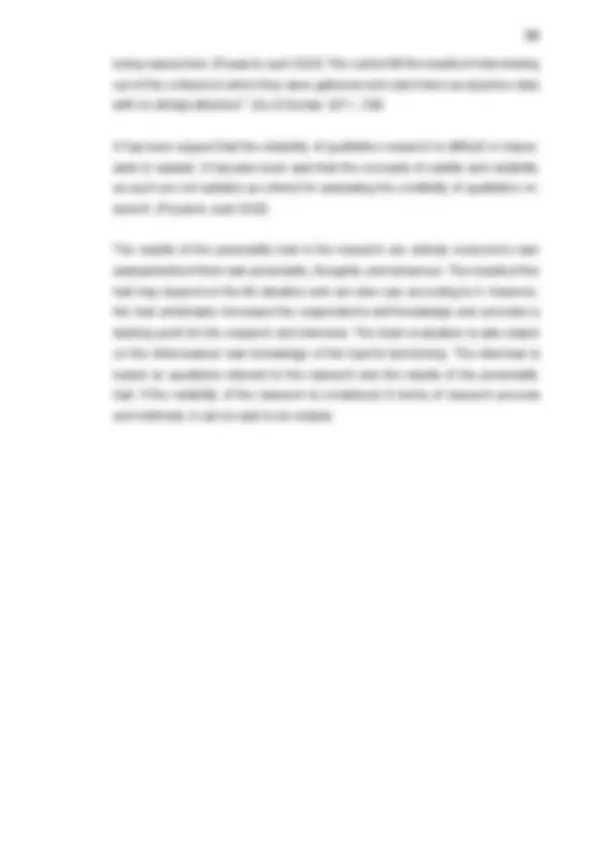
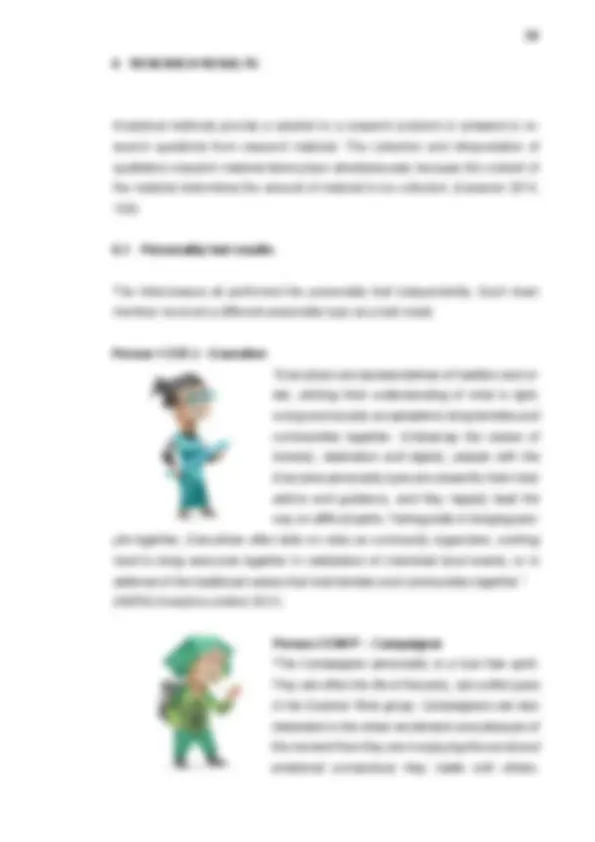
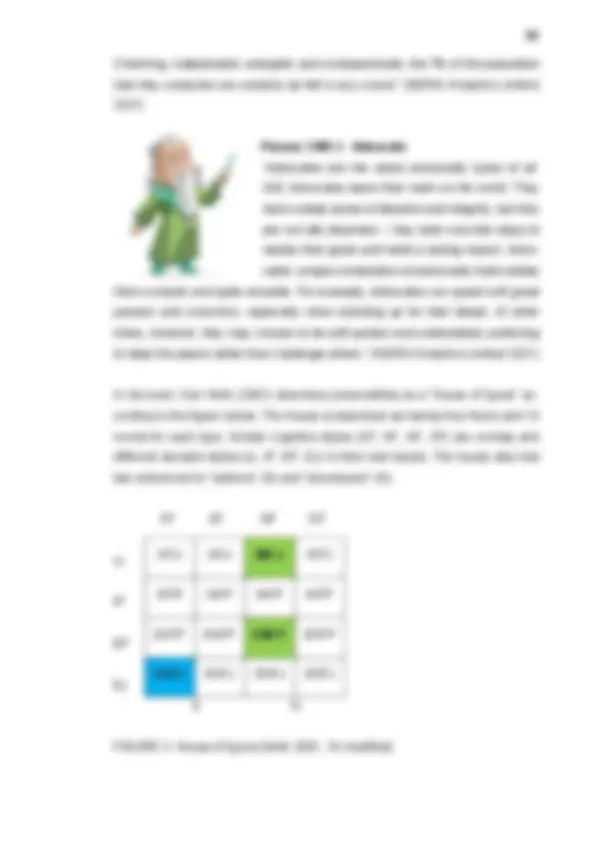
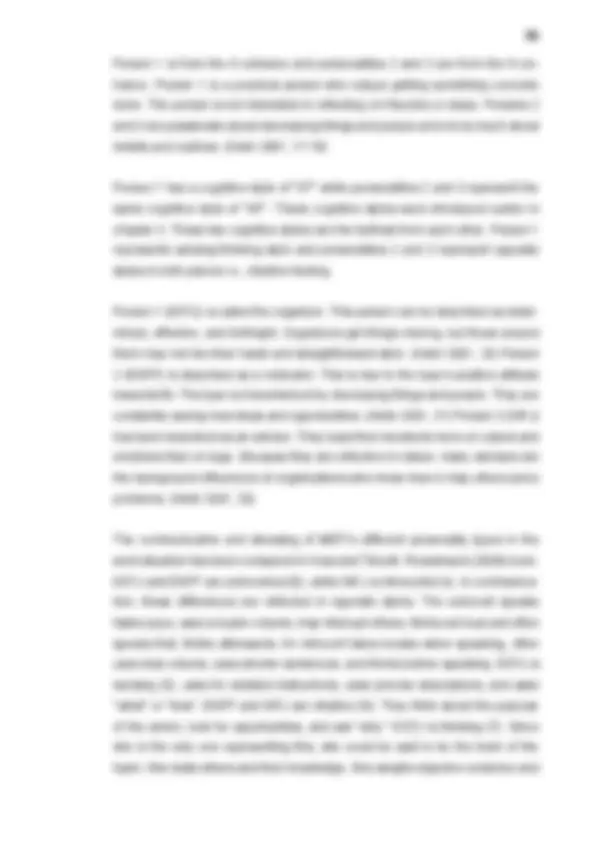
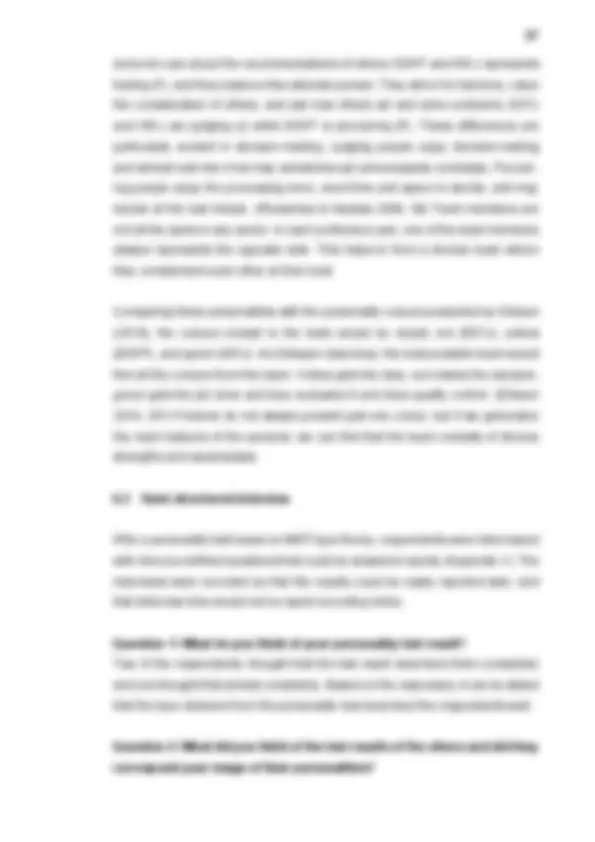
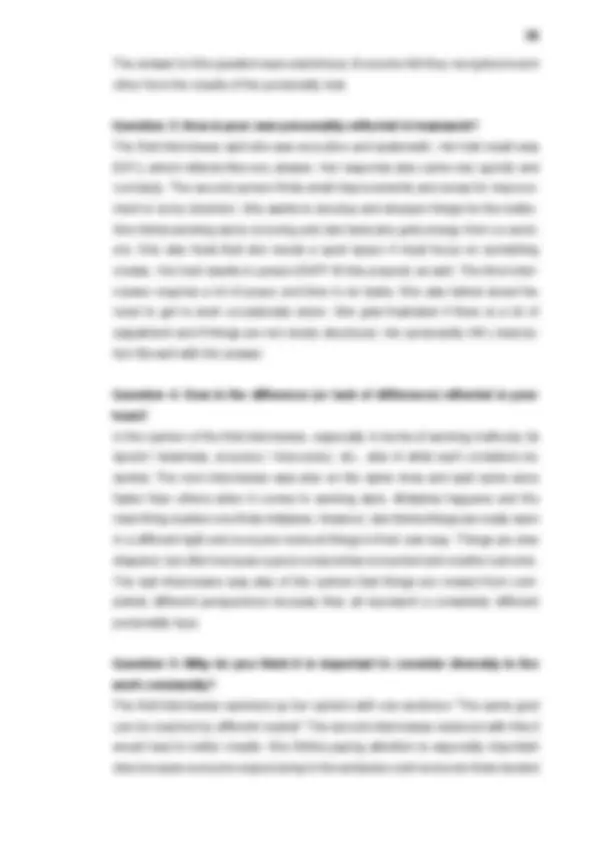
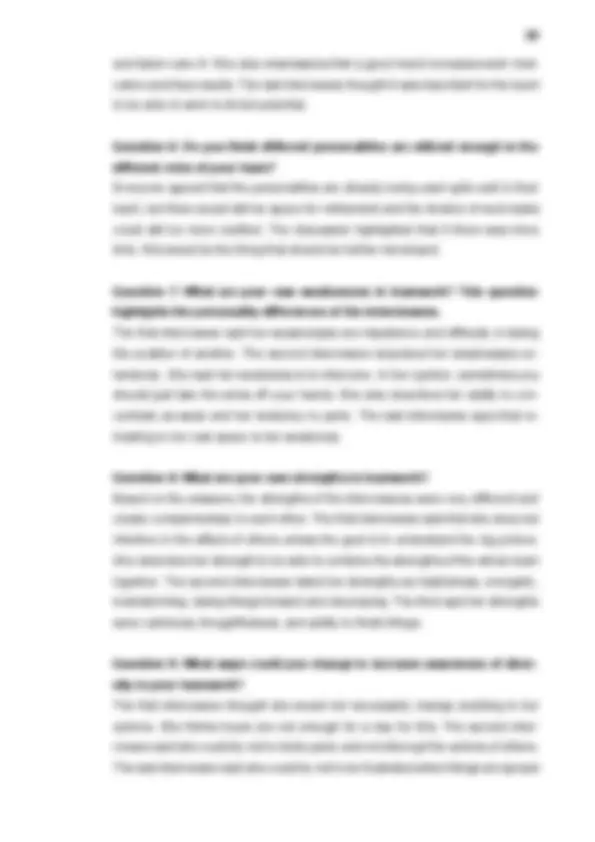
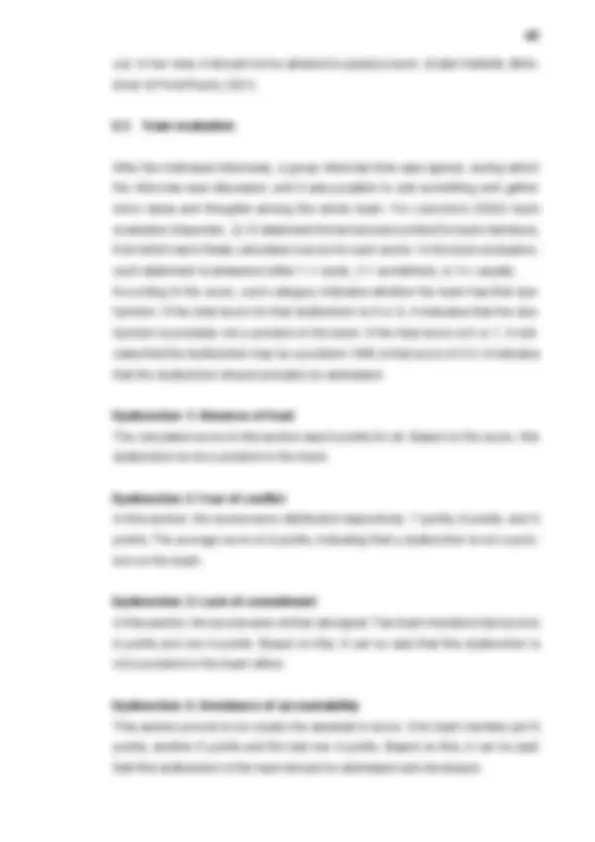

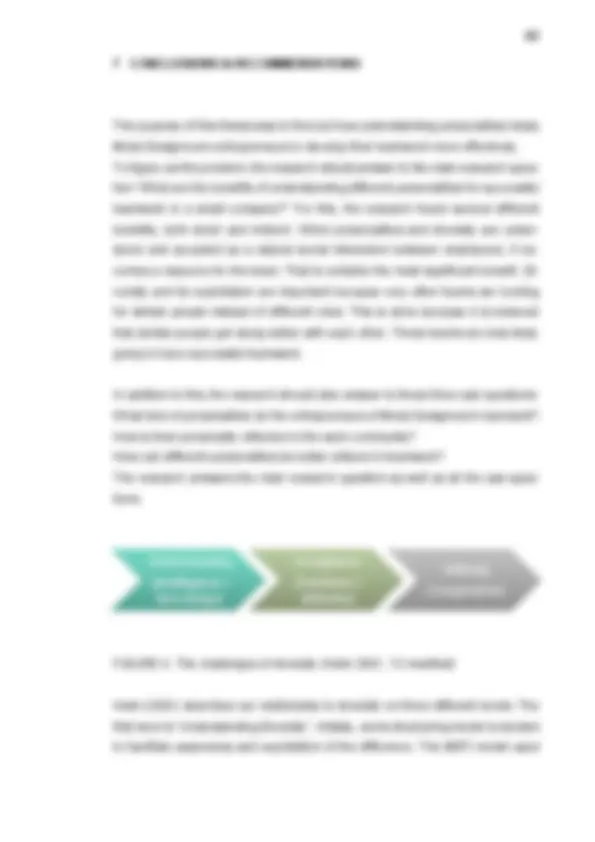
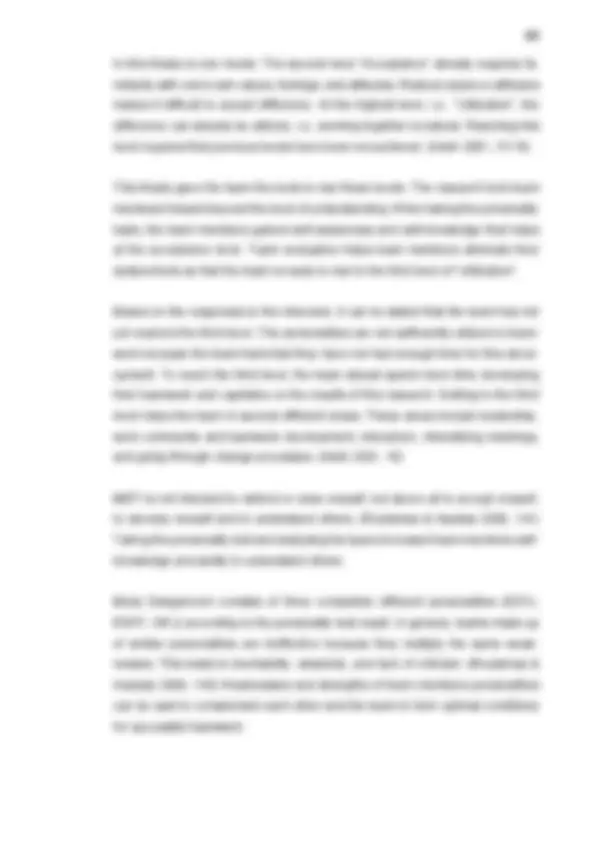
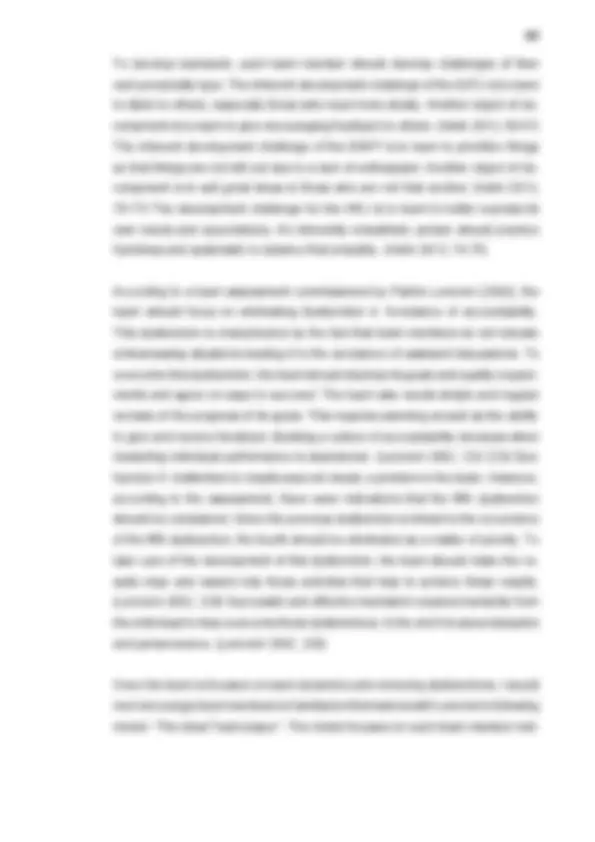
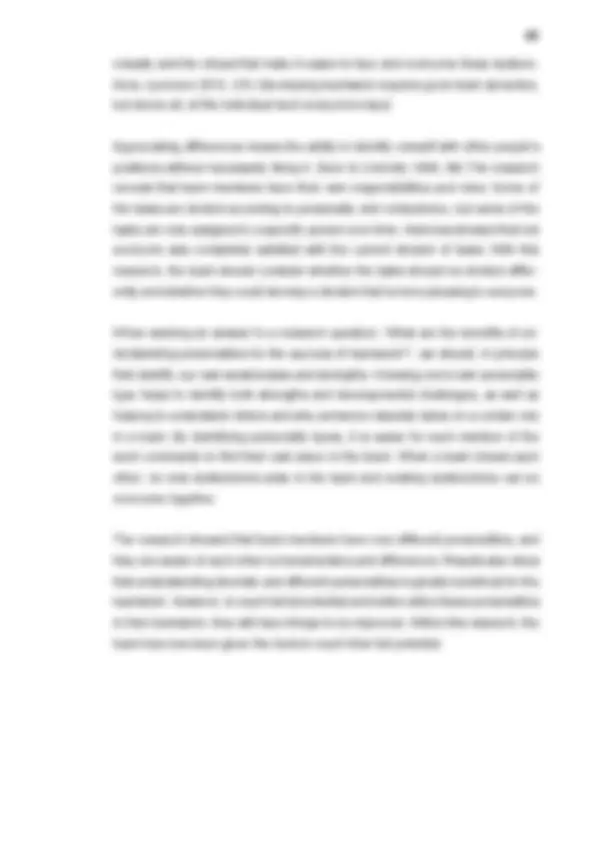
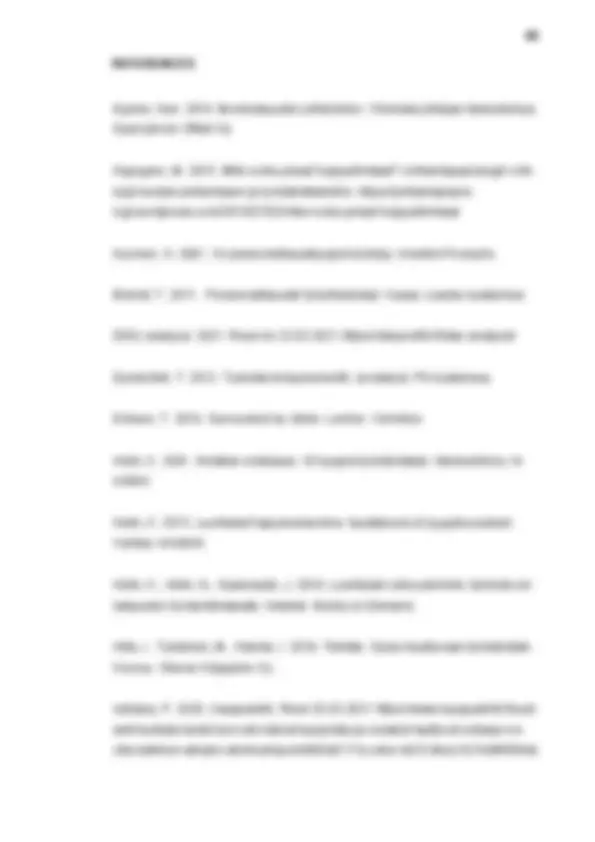
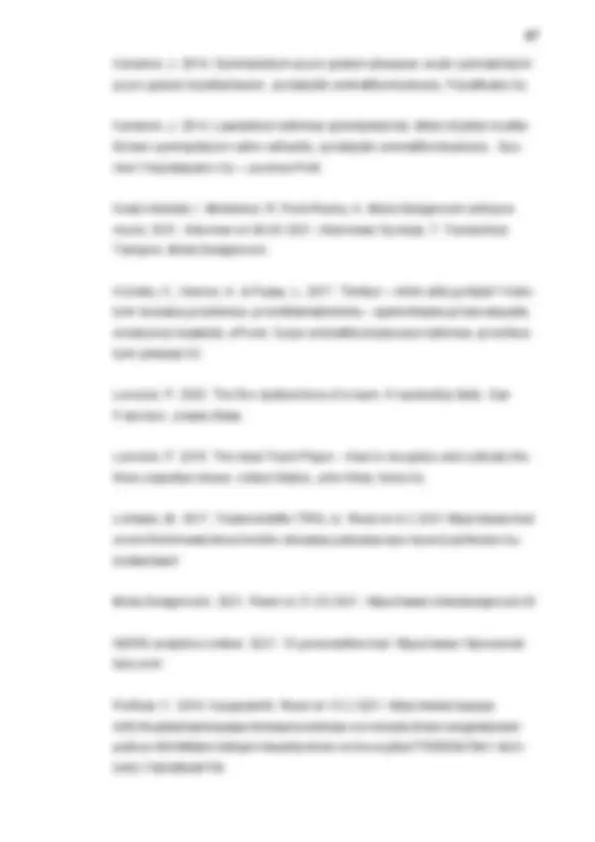
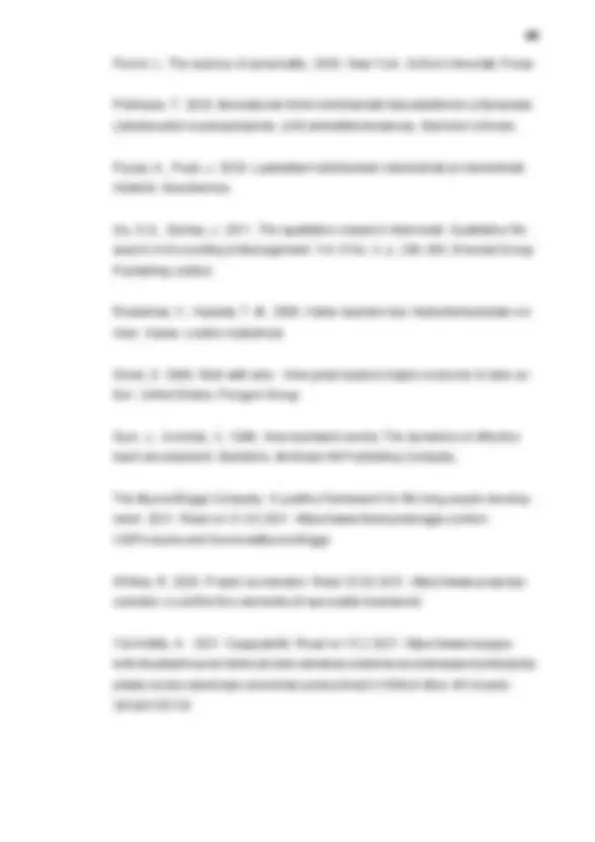
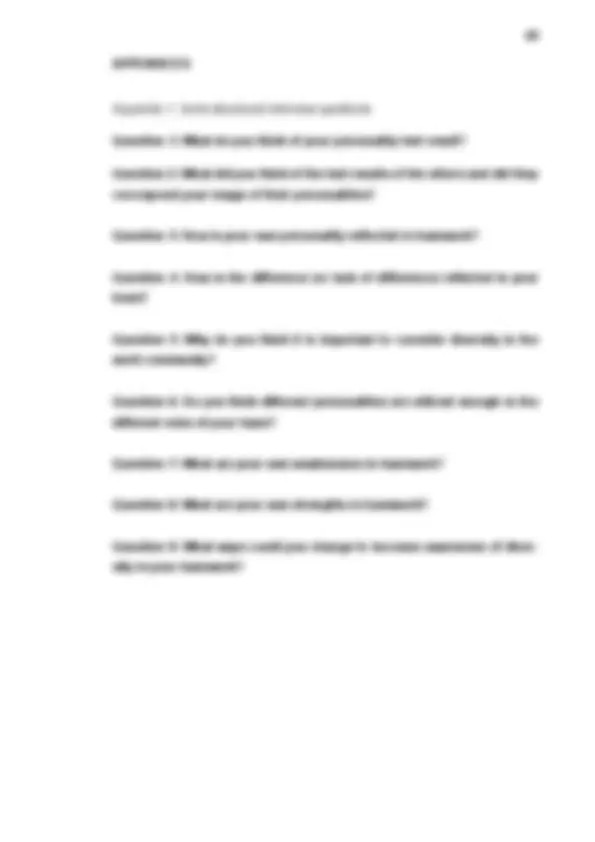
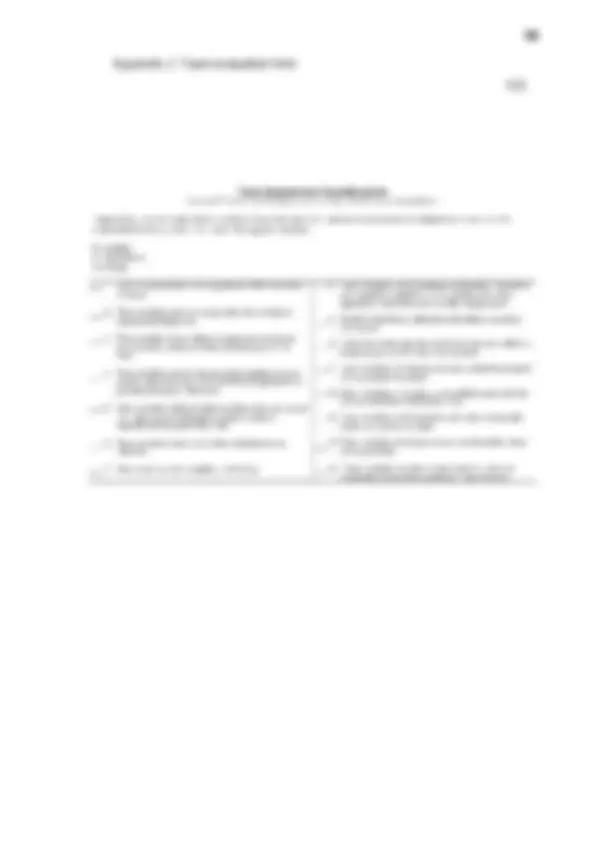
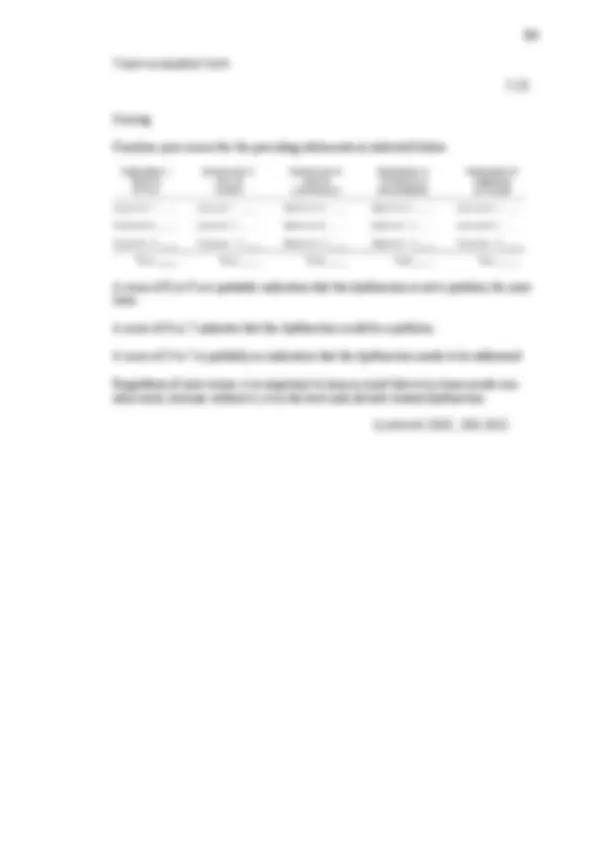


Study with the several resources on Docsity

Earn points by helping other students or get them with a premium plan


Prepare for your exams
Study with the several resources on Docsity

Earn points to download
Earn points by helping other students or get them with a premium plan
Community
Ask the community for help and clear up your study doubts
Discover the best universities in your country according to Docsity users
Free resources
Download our free guides on studying techniques, anxiety management strategies, and thesis advice from Docsity tutors
This bachelor's thesis explores the benefits of understanding personalities for successful teamwork in Miela Designroom, a small company consisting of three entrepreneurs with different personalities. The research question is 'What are the benefits of understanding different personalities for successful teamwork in a small company?' and the study includes interviews, team evaluations, and personality tests. the importance of teamwork, team development, and the five dysfunctions of a team, and provides recommendations for utilizing different personalities in team roles.
Typology: Study notes
1 / 51

This page cannot be seen from the preview
Don't miss anything!












































May 2021 International Business
Tampereen ammattikorkeakoulu Tampere University of Applied Sciences International Business Titta Syväoja: Understanding personalities as part of increasing the effectiveness of teamwork Case Miela Designroom Bachelor's thesis 51 pages, appendices 3 pages May 2021 This thesis was commissioned by Miela Designroom Oy. The company is a do- mestic design store focused on responsible fashion and consumption. The com- pany is run by three entrepreneurs and they started operations in 2018 as a pop-up store, from which the concept has been expanded to what it is now in
Understanding personality helps to be more empathetic and to understand why certain situations often recur in a team with the same formula. Breaking down personality into smaller parts helps identify and anticipate people’s reactions and ways of acting. This can help everyone see situations less through their own prejudices and examine the subject matter more objectively. (Lencioni 2002 , 204) This thesis aims to help local Finnish company owners to understand each other better and develop their teamwork more effective within that. The idea arose from interest and a desire to help local company on the road to success. Interest in diversity and personalities has always existed in me. This led to an attraction towards the HR field at the beginning of my studies. The commissioner company Miela Designroom has achieved growth in a short time. The aim of this research is to find the strengths, weaknesses, and person- ality types of Miela’s entrepreneurs and help the team become even more effec- tive. The covid-19 and the global situation have pushed companies, and many are in an acute cash crisis. Clothing and decor are first on the list when consumers start thinking about savings. People do not necessarily need new clothes because of layoffs or telecommuting. (Isotalus 2020) During this time, fashion companies can do nothing for the outside situation, but their own operations can always be im- proved. For those aiming to advance into leadership positions, it is crucial to understand the importance of personalities as part of the team. By understanding diversity and giving space to different personalities, the leader creates the conditions for successful teamwork.
This section introduces the topic of the thesis, the objective, and the purpose for the thesis. The plan also briefly introduces the methods and concepts. Data col- lection methods and their structure will also be clarified. The case company will also be introduced. 2.1 Miela Designroom Oy Miela Designroom is a Finnish design store that rents sales space in its store to Finnish fashion and design brands. Miela handles sales and marketing on behalf of brands, as well as in-store, e-commerce, and social media. In addition to Finn- ish design products, they also have a second-hand department. The store and the whole brand focus on responsible choices. The store was opened for the first time in June 2018 as a pop-up store called Showroom Finnish Brandstore. The idea for this was based on a thesis that considered modern business models. With a functioning pop-up store, it was decided to turn the business into a per- manent store. This is how the current Miela Designroom was created. (Miela Designroom 2021) Behind the company is a creative team of young women entrepreneurs. They have a common educational background, all of them have graduated from Tam- pere University of Applied Sciences' Pro Academy's degree program in Entrepre- neurship and Team Leadership. PICTURE 1. Miela Designroom logo (Miela Designroom 2021)
This topic has been studied from different perspectives and personality is often discovered more in psychological studies. There is a lot of research based on leadership about the topic. Many related studies often consider the personalities of leaders. How their personality, behaviours and actions affect the success of the company and communication with their subordinates. The idea for the topic came from personal interest of the effects of personalities, experiences during life and a concrete need in Miela Designroom. We should understand more of each other’s, so that we can succeed together better and feel more relaxed when being in the group. During my studies, when I was part of different group projects, I found that the dynamics and functionality of a group can be very different depending on what kind of personalities are part of the group. When doing my internship in HR-field, I realized that certain types of per- sonalities are suitable for such a position and environment. The topic itself is very up to date. In the future, employees will want to be seen more as individuals and emphasizing their personalities. This became out with the youth survey, commissioned by STTK, TYÖ2030 program. (Ylä-Anttila 2021) 2.3 Thesis objective, purpose and research questions Research has a developing objective. The objective of this thesis is to find out how understanding personalities helps them to understand each other better and how this helps to develop teamwork more effectively. The main research question is “What are the benefits of understanding different personalities for successful teamwork in a small company? “ Three sub-questions are derived from the research problem; What kind of personalities do entrepreneurs of Miela Designroom represent? How are their personalities reflected in the work community? How can different personalities be better utilized in teamwork?
The objective to research different personality types and its implications for teamwork has been supported by these sub-questions, which facilitate the per- ception of the whole. The growth of the Miela Designroom as a company has been rapid and they want constantly to develop themselves as well, so that they can also succeed better as a company. A team can succeed if each of its members understands their role and makes their full contribution to the team and its development. A successful team has clear goals and activities, an atmosphere of trust and open interaction, and a desire to develop. (Potinkara 2020, 2) In a successful team, members comple- ment each other in a way that creates an effective, versatile, and functional en- tity. Successful teams need an appropriate cocktail of roles that focus on think- ing, action, and people. They need to understand each other’s personalities, strengths, and skills to develop their teamwork to the highest. The research examines the types of personalities in the workplace. The pur- pose is to find out how these different personality types affect teamwork and learn to understand why each works on its own way. It is also intended to note whether tasks are divided according to personality weaknesses and strengths. 2.4 Concepts and Theory Several theories and concepts are used in this thesis. These theories are clearly presented and explained. When concepts are explained, it is easier for the reader to understand and read the thesis. The activities of entrepreneurs are viewed from a personality theory-based per- spective. The Myers-Briggs type indicator is used as a model for structuring per- sonality differences in this thesis (MBTI). MBTI is one of the world's most widely used personality indicator. Every year, more than two and a half million people fill out the form. (Routamaa & Hautala 2009, 19)
characteristics and stages. Teamwork is a form of collaboration and a way of doing work where all participants are aware of the team’s goals, reaching a com- mon goal, and the expertise of others. Team members have complementary skills, members strive for a common approach, and responsibility for achieving goals is shared among team members. Team development involves a variety of group dynamic phenomena and laws, as in all work groups: team stages and structures, acting as a team member and leader, and solving teamwork chal- lenges. (Koivisto, Henner, & Paaso 2017 ) 2.4.2 Successful teamwork When a team does not have any of Lencioni’s (2002) five dysfunctions, it can be assumed to be a successful team. These dysfunctions are described in more detail in Chapter 4. The Five Elements of Successful Teamwork:
The Golden Circle pattern created by Sinek (2009) tells us how to always start with the why question, then think about how , and lastly answer the what question. Most businesses and people start moving from the outer edge of the perimeter and move towards the centre because what and how the questions are easier to understand because of their physical existence. Behind successful teamwork, the team members have internalized the reason for the team’s existence, and they go together towards their goals. The team has also found an answer to their own why question, meaning what they wake up to every morning to work for their own team. (Sinek 2009, 37-39) 2.5 Working methods and data This section briefly explains the data collection methods, theories and models used in this thesis and how they apply to this research. The research is imple- mented as a qualitative research. It is appropriate for the research to find out the personality types of the company's members. It is going to be executed by personality tests, team evaluation, interviews with the entrepreneurs of Miela and the available materials related to the topic. The interview will be conducted as a semi-structured interview. A semi-structured in- terview is freer than a structured interview. The advantage of this is that the re- searcher receives views from the interviewees on the most important and pre- defined topics of its research in their own words. The semi-organized and partly open interview is formally placed between a fully structured form interview and a thematic interview. (Puusa, A & Puuti, J. 2020, 111) The use of several methods is intended to understand the phenomenon from several perspectives, which in- creases the reliability of the study. 2.6 Thesis process This chapter goes through how the thesis progresses. The first chapter of the thesis is the Introduction and the second thesis plan. Thesis plan explains the objective and purpose of the research to the reader. It also presents the target
Personality is a broad concept. It means the physical, social, mental, and spiritual whole of a human being. From a scientific point of view, a person’s overall per- sonality is deep and partly enigmatic to research. (Dunderfelt 2012, 14) Psychologist Tony Dunderfelt divides personality into distinct dimensions. The physical self , which means our anatomical and physiological whole. Our physical self is visible to the outside, while other dimensions work more inside. Role me , means the image we form of ourselves according to which social communities we are part of. Culture me is formed by different hobby groups and subcultures. Raised me takes the effects from our parents, growth environment, school, friends, and relatives. Temperament is innate and is the style and way we react to prevailing conditions. Temperament is reflected in external behaviour. Core me is the dimension of our personality that can make independent choices. Through this part, we are also able to develop other dimensions and increase self-aware- ness. We walk daily with our physical body in social and cultural contexts, act according with our roles, carry with us our learned past, and strive to make inde- pendent decisions. (Dunderfelt 2012, 15-18) Acceptance of diversity is still fragile today, and Finland is one of the leading countries in terms of workplace bullying. According to research commissioned by Routamaa and Hautala (2009), 43% of the respondents had experienced bullying in the workplace. The same 43% felt that the personality of the bullied contributed to being the target of bullying. Increasing the self-knowledge of members of the work community with a common concept is said to reduce bullying. This assump- tion is reinforced by the experience of those who commissioned the research on the successful coaching of contentious work communities by increasing work community’s self-knowledge and self-awareness. (Routamaa & Hautala 2009, 142 - 143) The atmosphere in the work community has a major impact on well-being at work, which affects to work productivity and how well people are feeling at work. Every member of the work community should take care of this at the individual level.
According to Thomas Erikson, behaviour is a function of personality and circum- stance factors. Behaviour is something we can observe. Personality is a factor we strive to understand and circumstance factors are things we can influence. We constantly influence each other in some way. Therefore, it would be good to try to understand what is beneath the surface. (Erikson 2019, 29) 3.1 The importance of self-knowledge Self-knowledge refers to an individual’s own understanding of themselves. With- out this understanding, it is impossible to be able to lead others. Knowing one’s own thoughts, ideas, opinions, feelings, and ways of working are all part of self- knowledge. When increasing self-knowledge, it is essential to be aware of one’s own needs and desires, weaknesses and strengths, beliefs, and values. This increases the ability to lead oneself. Our own ideals are strongly related to self-knowledge and our own experiences of what we are now and what we want to become. One’s own feelings for themself are strongly related to self-knowledge. The relationship can be negative, neutral accepting, or positive. Self-knowledge is born and it evolves in relation to other people, how we have become encountered, treated, and what we have heard others saying about us. Based on experiences from others, self-knowledge is not a fact but a subjective view of one’s own value and goodness that can be changed and developed by limiting ourselves. (Ajanko 2016 , 148 - 149 ) Self-knowledge is a prerequisite for all positive development and development of the individual, group, and organization. (Routamaa & Hautala 2009, 13) Above all, self-knowledge helps to find your own weaknesses and strengths. Being aware of these, oneself is better to lead and develop. Self-knowledge helps to accept oneself better. When you accept yourself, it is easier to accept the differences of others as well. "Only those things that you accept in yourself will be accepted in others." When you understand the differ- ences of others, it makes it easier to collaborate with other people. (Helin, Helin & Saarenpää 2018, 149 )
The MBTI type indicator is based on the observations of the Swiss psychiatrist Carl Gustaf Jung about the diversity of people's personalities. Jung published a book called “Psychological Types” in 1921. He developed his theory by studying his colleagues’ psychological neuroses. When making observations of them, he noticed that both dealt neuroses from opposite sides, and not as a whole. Jung concluded that both looked at the matter based on their own innate preferences. This finding was a central part of Jung’s twenty-year research of human diversity. (Auvinen 2001, 9) Carl Gustav Jung is considered the father of mindset theory. According to Jung, people are directed to the external and internal world. He began to call those more strongly oriented to the external world extroverted and those more strongly oriented to the inner world introverted. These were the first preferences. Later Jung added mental dimensions to the preferences. The sensing - intuitive image is a way of perceiving the world, and the thinking - feeling describes of the way to make decisions. (Helin, Helin & Saarenpää 2018, 239- 241 ) Jung’s theory was not made known to the public consciousness until the 1960s after the American Katharine C. Briggs and her daughter Isabella Briggs-Myers adapted Jung’s ideas into a practical tool. Myers and Myers-Briggs added a fourth preference to the dimensions perceived by Jung, judging - perceiving, which de- scribes a lifestyle. Studies on the reliability and validity of the type indicator were completed in the early 1970s, and in 1975 the first commercial version was pub- lished. (Routamaa & Hautala 20 09 , 16-18) The Myers-Briggs Type Indicator has been in use in Finland since the 1980s, but the actual research and validation subject to authorization originated on the initi- ative of Vesa Routamaa in the early 1990s. MBTI has been studied at the Uni- versity of Vaasa under the lead of Routamaa for more than 20 years. Their re- search results show that the importance of understanding personality types is more emphasized in management work and its development, conflict resolution, employee personal development and team building. Understanding your own type of preferences can help you plan your career and approach work more ap- propriately to your own style in terms of a pleasant work environment, work tasks,
problem solving, time management, decision making and stress management. (Routamaa & Hautala 20 09 , 8- 10 ) MBTI analysis provides a quick and easy way to get an idea of human behaviour. It allows us to get to know ourselves and our innate abilities better. With MBTI, people learn to be aware of and take advantage of difference. It makes it easier for us to understand which factors in different interaction situations cause conflicts and discord. For this reason, it is ideally suited to the development of work com- munities and the use of their potential. (Auvinen 2001, 8- 9 ) 3.3.1 Preferences The MBTI model includes four different preferences. They describe the direction of energy, perception, decision-making, and your lifestyle. Based on these, 16 different personality types are created which are described by a combination of four letters. Each personality type represents one of these counterparts. (Table 1.) However, distinguishing between different types of traits does not mean that a person would not be able to take a different way of thinking or approaching. Each person uses some extent in their opposite preference. Definition refers to the way of thinking or the way a person comes naturally and uses them more strongly. (Brandt 2011, 18) TABLE 1. Preference pairs (Brandt 2011, 17) Extraversion (E) Introversion (I) Sensing (S) Intuition (N) Thinking (T) Feeling (F) Judging (J) Perceiving (P) Energy direction: Extrovert – Introvert Extroverts direct their energy outward, into things and people. They get their en- ergy from being active and interacting with others. Introverts mainly focus on their inner world of experience and ideas. They are energized by pondering and spending time alone. In working life, extroverts are eager to get started, want to
3.3.2 Cognitive styles Four different cognitive styles describe the common characteristics of different personality types. Cognitive style consists of the middle letters of the personality type, i.e., perception and decision-making preferences. There are four cognitive styles: sensing-thinking (ST), sensing-feeling (SF), intuitive-feeling (NF), intuitive- thinking (NT). (Brandt 2011, 22) Cognitive style is often used in the MBTI literature to facilitate the handling of things. It is easier to draw conclusions as well as remember things about four different personality trends than sixteen different types. (Routamaa & Hautala 2009 , 61) Sensing - Thinking ST (ESTJ, ISTJ, ESTJ, ISTP) ST relies on analytical thinking when observing its senses and making decisions. ST's data collection process is practical and realistic. When making decisions, ST strives for objectivity. ST´s interests are usually focused on facts, as the person can process and differentiate them through its senses. ST is a practical and fac- tual person and does not like to take risks. In working life, ST can be found in the following fields: law, business, accounting, production, surgery, and machinery and material handling. (Brandt 2011, 24) Sensing - Feeling SF (ESFJ, ISFJ, ESFP, ISFP) SF's data collection process is also practical, and SF also relies on its senses when observing its environment. When making decisions, SF prefers its own val- ues and feelings. SF approaches decision-making situations with its personal warmth because SF’s values and feelings determine how much things mean to personally. SF is more interested in people and relationships than things in gen- eral. SF is sympathetic in nature, social and friendly. In working life, SF likes to focus on areas where kindness and warmth is effectively in use. These areas are, for example, teaching, selling concrete things, medical care and other areas of health care that may be in direct contact with the patient. (Brandt 2011, 24)
Intuition – Feeling NF (ENFJ, INFJ, ENFP, INFP) When observing, NF relies on intuition. NF does not pay as much attention to the concrete situation as the ST and SF. NF prefers to focus on all types of possibil- ities, such as new projects, events, and ideas. New ideas arise as a result of a subconscious process that comes to NF’s consciousness in quick flashes. When making decisions, the NF prefers its own values, like SF. NF likes people and is happy to focus on people-oriented fields. NF´s best side is ability to work with as many different people as possible and get the best out of each of them. NF is polite and persuasive and often has a great need to help others. By nature, NF is usually a positive idealist. NF enjoys the work of allowing creativity, especially if it can still work with or for people. NF can often be found as a teacher, selling abstract things, as a consultant, writer, or researcher. (Brandt 2011, 24- 25 ) Intuition – Thinking NT (ENTJ, INTJ, ENTP, INTP) In the perception process, NT relies on intuition like NF. NT is happy to gather information and observe abstract things and possibilities. In making the final de- cision on all possibilities, NT ends up being analytical. NT tends to apply theory to everything and enjoys doing things in new ways. NT easily perceives wholes and conceptualizes things. NT expresses itself clearly and precisely when speak- ing. NT can see the logic and principles of things deeper than the surface. Be- cause of that, NT often focuses on being a researcher, strategic planner, or in the technical and administrative fields. (Brandt 2011, 25) 3.3.3 Summary of 16 personality types ISTJ – Logistician “Practical and fact-minded individuals, whose reliability cannot be doubted.” (NERIS Analytics Limited 2021) Serious, responsible, and systematic type. Keeps things organized and strives for its goal despite disruptions. (Brandt 2011,
ISTP – Virtuoso “Bold and practical experimenters, master of all kinds of tools.” (NERIS Analytics Limited 2021) Calm and reserved, takes things realistically and works effectively in crisis situations. (Auvinen 2001, 36)